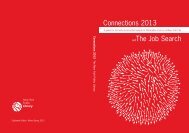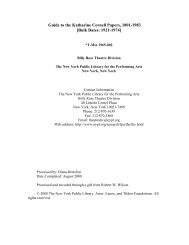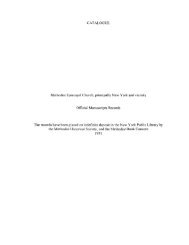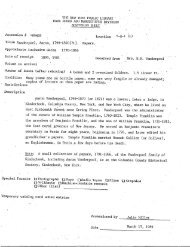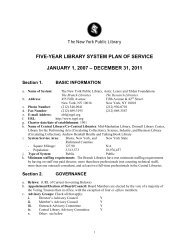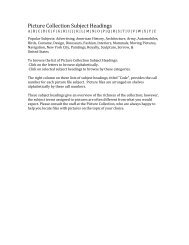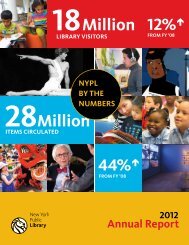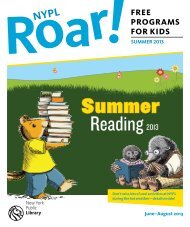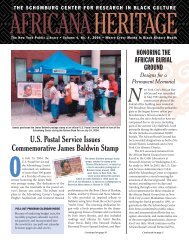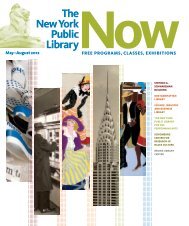Understanding Black Liberation Theology: A 40-Year Retrospective
Understanding Black Liberation Theology: A 40-Year Retrospective
Understanding Black Liberation Theology: A 40-Year Retrospective
You also want an ePaper? Increase the reach of your titles
YUMPU automatically turns print PDFs into web optimized ePapers that Google loves.
f r o m t h e Chief<br />
More than 80 years have passed since the Harlem<br />
Renaissance peaked in the mid-1920s.<br />
Nevertheless, the legacy of the Harlem<br />
Renaissance—as much myth as fact—lives<br />
on. The leading writers of the Renaissance—Hughes,<br />
Cullen, Hurston, McKay, to mention only a few—<br />
have become part of the cannon of American literature.<br />
Its musical giants—Ellington, Henderson, Calloway,<br />
etc. are still revered by blacks and whites alike.<br />
Its visual artists, on the other hand, have suffered a<br />
different fate, perhaps because the real flowering in<br />
visual arts did not occur until the era of the Great<br />
Depression in the 1930s. The pioneers of the Renaissance’s<br />
visual arts expression were there in the midto-late<br />
twenties, however, along with the writers and<br />
the musicians. Ironically, many of the visual artists<br />
have become invisible or forgotten.<br />
Aaron Douglas was one of those pioneers —<br />
perhaps the preeminent pioneer. He arrived in<br />
The Schomburg Center is doing its part<br />
to keep the spirit of the Renaissance<br />
alive, especially in the fields of literature,<br />
and the performing and visual arts.<br />
— Howard Dodson, Schomburg Chief<br />
Harlem in 1924 from Kansas, bringing with him a<br />
developed artistic talent. He went to work as an artist<br />
almost immediately and quickly put his visual and<br />
graphic imprint on the movement. Within a year<br />
of his arrival, his work had appeared in the Crisis<br />
and Opportunity magazines, the two most vocal<br />
proponents of the Renaissance. When Alain Locke<br />
looked for an artist to illustrate, his now classic of<br />
the Renaissance, The New Negro in 1925, he turned<br />
to Douglas. It was as a muralist, however, that he<br />
would establish himself as the leading artist of the<br />
Renaissance. Over 80 years later, he is finally being<br />
recognized as the pioneering artist that he was.<br />
Aaron Douglas: African American Modernist is the<br />
first ever major retrospective of Aaron Douglas, the<br />
leading Harlem Renaissance visual artist. Comprised<br />
of some 100 works, the exhibition was organized<br />
by the Spencer Museum of Art at the University of<br />
Kansas, and curated by Dr. Susan Earle, Curator<br />
of the Spencer. Over the last year, the exhibition<br />
has traveled from the Spencer to the Frist Center<br />
for Visual Arts in Nashville, Tennessee and the<br />
Smithsonian American Art Museum. The Schomburg<br />
Center is pleased to welcome Aaron Douglas and his<br />
art back to Harlem. We also welcome his signature<br />
mural series, “Aspects of Negro Life” which have been<br />
the centerpiece of the exhibition, back to their home<br />
at the Schomburg Center. As we celebrate the return<br />
of Aaron Douglas, we also commemorate the life and<br />
departure of one of the stellar leaders of the second<br />
Harlem Renaissance, Dr. Barbara Ann Teer, Founder<br />
and CEO of Harlem’s National <strong>Black</strong> Theater. She<br />
made her transition on July 21 in the <strong>40</strong> th year of the<br />
Theater’s founding.<br />
The seeds of still another Harlem intellectual<br />
renaissance were planted this summer during a sixweek<br />
Summer Institute in the Humanities funded<br />
by the Andrew W. Mellon Foundation. This issue of<br />
Africana Heritage, reports on the results of this path<br />
breaking program for rising seniors from New York<br />
City colleges and universities and Historically <strong>Black</strong><br />
Colleges and Universities.<br />
The Schomburg Center is doing its part to<br />
keep the spirit of the Renaissance alive, especially<br />
in the fields of literature, the performing and visual<br />
arts. It is estimated that during an average month<br />
in contemporary Harlem, the cultural institutions<br />
produce and present more art than occurred in the<br />
entirety of the Harlem Renaissance. This season’s<br />
public programs calendar includes some of the<br />
Schomburg Center’s contributions to the vitality<br />
of contemporary Harlem’s cultural life. I especially<br />
invite your attention to the literary series The<br />
Schomburg Reading Room: Writers on the Cutting Edge<br />
that starts in September and runs through May. I also<br />
encourage you to check out the literary and musical<br />
tributes to Aaron Douglas included in this season’s<br />
program lineup. And don’t miss the exhibition Aaron<br />
Douglas: African American Modernist as we welcome<br />
him back “Home to Harlem.”<br />
2 Africana Heritage • Volume 8, No. 4, 2008 • Where Every Month Is <strong>Black</strong> History Month




